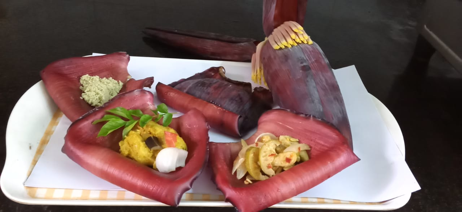
Serving food on fallen petals of banana blossoms? Quite funny! Yes, it is. Of course we don’t do that at home. But why not? Look at these quaintly elegant organic crockery from nature. Their colour and shape would certainly add a special flavour to what is served in them. Children, I suppose, would like them. Even adults may enjoy it. This was recently tested and proved in a common meal with my friends. This takes me back to the pre-school days when we small kids used to enjoy playing the traditional “kanji and curry” game. The mom’s role usually fell on me, because a stout older girl in the team always assumed the father's role. You see, trans-gendering was so easy for children! The poor mother had not only to cook but also find the necessary utensils and plates. The freshly fallen banana blossom petals were the easiest and the cutest thing for her around.
Advancing in age one is intrigued by the mystery of the banana blossom. It is not one single flower, but a tightly sealed casket of thousands of small flowers, arranged in layer upon layer, each layer safely covered by a protective half-sheath or petal. Every night one sheath will open up and unveil its hidden treasure of a bunch of flowers. Each flower carries in her heart some delicious honey around which bees and bats, beetles and squirrels celebrate a feast.
Every flower is potentially a future banana, but not all come to fruition. Nature intends it because if all flowers bring forth bananas the fragile plant will collapse under their weight.
As the feast comes to an end the flowers come of age to produce the fruit. The protective sheath then folds back. Assuming an elegantly curved shape, it gently falls to the ground in silent satisfaction.
Yes, it would be great fun if we occasionally let our children collect such clean freshly fallen petals and make a little joyful feast at our home tables in honour of the great mystery of creation.
∎